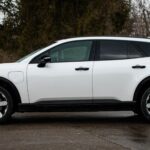Ford is strategically shifting gears towards plug-in hybrid technology, particularly for its larger vehicles like SUVs and potentially its robust pickup trucks. CEO Jim Farley recently highlighted this direction, emphasizing the development of extended-range electric vehicle (EREV) technology as a solution to meet customer demands for range and affordability in the electric vehicle market, especially for trucks.
This innovative approach involves a gas-powered generator working in tandem with a battery to power the vehicle’s electric motors. This system isn’t about direct gasoline propulsion; instead, the gasoline engine acts purely as a generator, recharging the battery that, in turn, drives the wheels via electric motors. Ford envisions this setup achieving up to 700 miles of combined range, addressing a key concern for truck and SUV owners who require dependable long-distance capability.
The architecture Ford is considering for these plug-in hybrid trucks and SUVs will utilize both body-on-frame and unit-body platforms. Body-on-frame construction, typically found in pickup trucks and larger SUVs, provides the ruggedness and durability needed for these vehicle types. This contrasts with unit-body construction, common in cars and smaller crossover SUVs, where the body and frame are integrated. Ford’s flexibility in platform design suggests a broad application for their plug-in hybrid system across different vehicle categories.
Farley specifically pointed to the impressive 700-mile range target for these EREV systems. This extended range is crucial for larger vehicles, combining the benefits of electric driving with the reassurance of gasoline backup for longer journeys. This series-hybrid system, augmented with plug-in capability for a substantial all-electric range, mirrors the pioneering technology seen in vehicles like the Chevrolet Volt and the upcoming 2025 Ram 1500 Ramcharger. Even Volkswagen’s Scout Motors is venturing into this space, planning an EREV option named ‘Harvester’ for its Traveler SUV and Terra pickup, slated for release in 2027, alongside fully electric models.
While the exact timeline for Ford’s EREV powertrain remains unclear, reports suggest a potential arrival as early as 2027. Bloomberg’s report indicated that this technology might extend beyond SUVs to include Super Duty heavy-duty pickups, although Farley’s initial comments focused on SUVs and some of the larger pickup models. The deployment in Super Duty trucks would represent a significant step in electrifying even the most demanding vehicle segments.
Farley articulated the economic challenges of fully electric large SUVs, noting that “the economics are unresolvable” for these vehicle types in all-electric configurations for retail customers. He explained that customers of larger SUVs and trucks have “very demanding use cases,” including towing, off-roading, and long road trips. These demands translate to the need for very large and expensive batteries due to the vehicles’ size, weight, and less aerodynamic profiles, making full electrification less economically viable for the average consumer in this segment.
Despite fleet customers showing a greater willingness to invest in fully electric trucks, retail demand has proven more price-sensitive. Ford’s recent price reductions on the F-150 Lightning electric pickup truck underscore this point. However, Farley emphasized that the incremental cost of an EREV system is “very minimal,” suggesting that plug-in hybrid trucks and SUVs could offer the desirable attributes of electric driving without imposing a significant price premium on consumers. This approach allows Ford to provide a more accessible entry point into electrification for truck and SUV buyers.
This strategic pivot towards plug-in hybrids for larger vehicles is further evidenced by Ford’s earlier decision to abandon plans for a battery-powered, three-row SUV and to increase its hybrid vehicle production across its lineup. Farley’s latest statements reinforce Ford’s commitment to hybrids and extended-range EVs as a crucial part of their electrification strategy, particularly for the truck and SUV market. By focusing on plug-in hybrid trucks, Ford aims to deliver a practical and cost-effective solution that bridges the gap between traditional gasoline engines and the all-electric future, meeting the immediate needs and expectations of truck and SUV customers.
